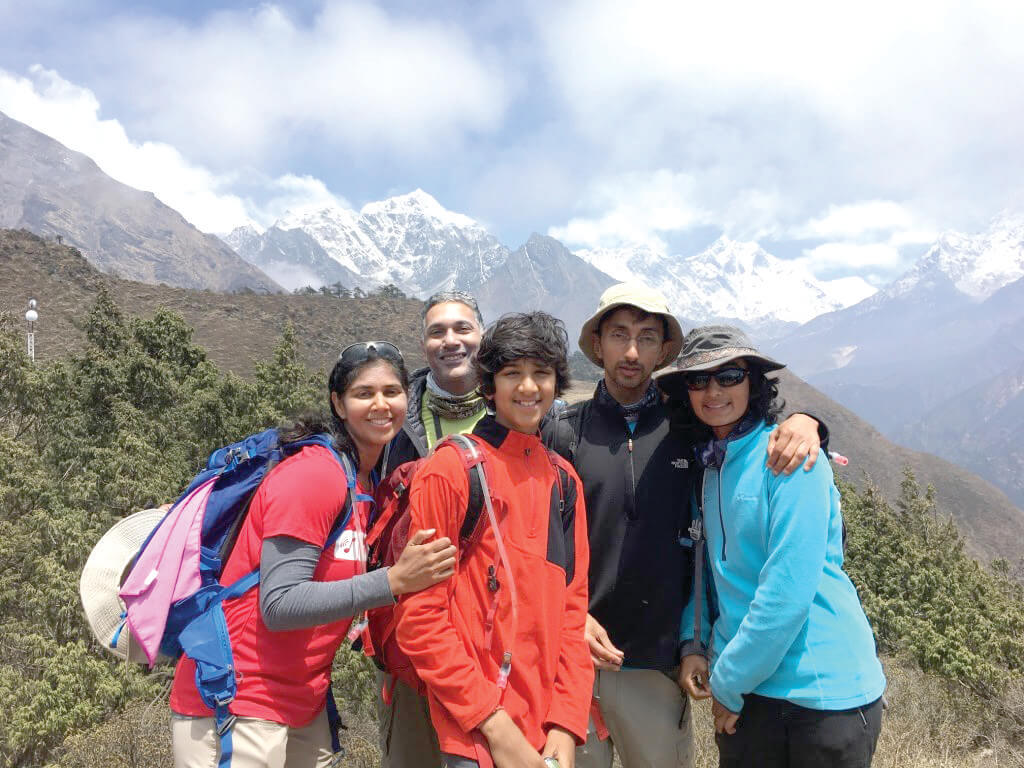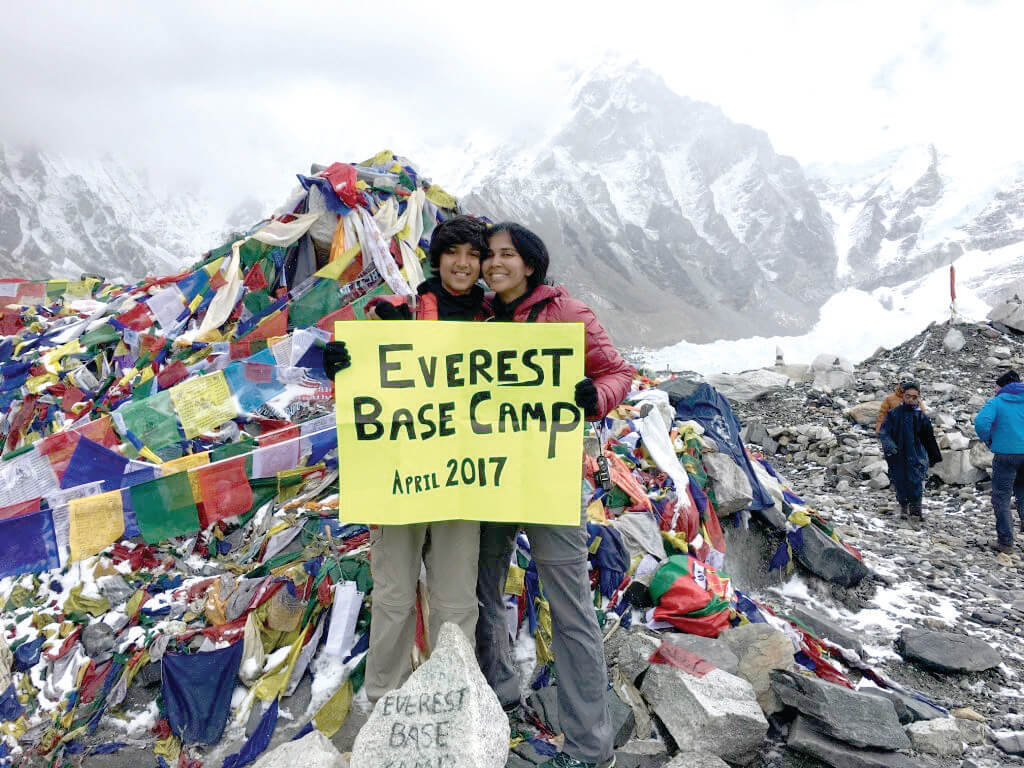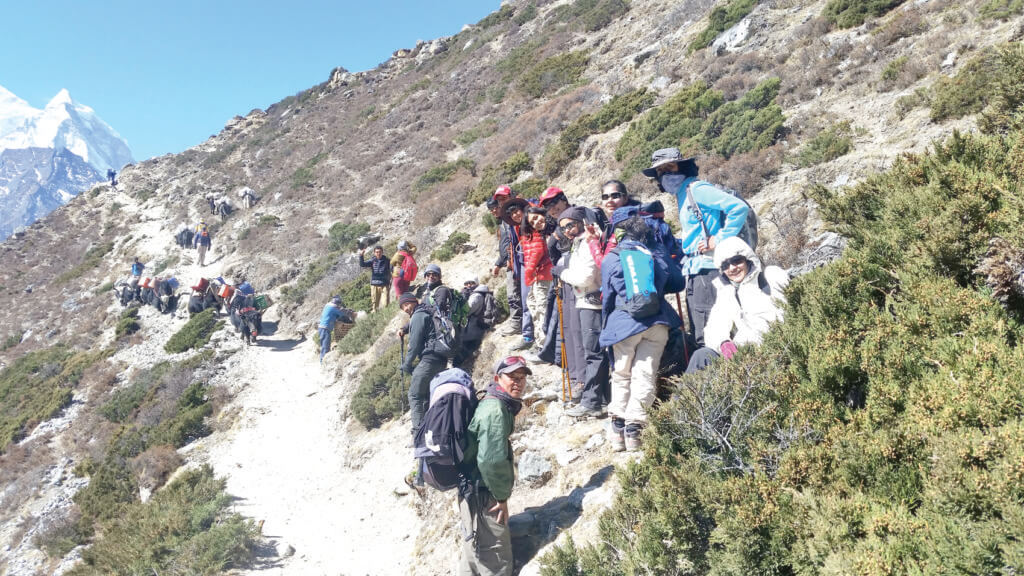
The Steiner Ranch gang with Everest behind them. From left, Payal Chawla, Jayant Vohra, Rohit Chawla and Nainish and Aanika Dalal.
Trek to Mount Kala Patthar,
elevation 18,515 feet
By SARAH DOOLITTLE
Four Points News
Steiner Ranch residents Payal Chawla and her son Rohit experienced the adventure of a lifetime when they visited Everest Base Camp in April.
The stay-at-home mom and eighth grader hadn’t ever even thought about traveling to Nepal to climb to elevations over three miles high.
“Friends of ours were going, and happened to mention, hey, we have a group going. I didn’t think much of it.” But as she discussed the idea with Rohit, the idea began to gain traction, even though it would require three weeks of travel, missed school and leaving her husband and 5th grader behind. Still, Payal thought, “Now is a good time,” before Rohit started high school and college.
Rohit and Payal’s only outdoor experience prior to Everest was camping with their family. So why the leap from car camping to trekking in the world’s tallest mountains? “I just thought of it as an experience that not many people get to have,” Rohit explained.
Preparing for adventure
The trip was organized by the friend-of-a-friend, and their group consisted of 18 people, including another family from Steiner Ranch and families from around the U.S. and India.
Rohit and Payal Chawla visited Everest Base Camp for 45 minutes and celebrated with a photo in front of a pile of Tibetan prayer flags.As for training to hike to the camp where climbers first stop before ascending the world’s highest mountain, “We (trained) a little bit,” said Rohit, including hiking trails in Steiner and hitting the StairMaster at the gym. While Payal gradually worked her way up to a goal of climbing 255 floors’ worth of stairs at the gym, Rohit accomplished the same goal on his first try.
Despite their lack of rigorous training — “What we didn’t do and should have done was train with backpacks,” said Payal — the pair still looked forward to a new adventure.
They first flew from Austin to Dubai, then on to Kathmandu, Nepal. Landing in Nepal on its single runway, Rohit noticed right away that, “There’s a lot of poverty there,” something he had already experienced while visiting family in India. “It’s not as developed. It’s not as clean,” as opposed to Dubai and the luxury car dealership they visited while on layover there.
What struck Payal right away was that, “Practically half of the people you see in the Nepal airport are trekkers… It’s so funny. Standing at baggage claim, everything that’s coming out is a duffel bag.”
Though a novice, Payal couldn’t help but think that, “For a second you feel like, I’m one of them.”
In her and Rohit’s duffel bags: lots of layers, Camelbacks (water bladders), hiking boots, sleeping bags, and more — all of it bought new just for the trek.
The group spent two days in Kathmandu (elevation 4,593 feet) before flying to Lukla (elevation 9,383 feet). For comparison, the city of Austin has an elevation of 489 feet.
A simpler way of life
The group began their climb from the Lukla airport, making a series of stops as they gained elevation. Each person carried only about eight pounds of weight (mostly water, which they all learned to carry as little of as possible). Sherpas and yaks carried the rest, including the group’s gear, a medical kit and food.
Along the way they sometimes stopped for a full day in order to better adjust to the gain in elevation. On those days of rest, however, they were still required to climb and then return to their lodgings to help with acclimatization.
A series of extremely basic lodges provided shelter along the route — “A room with two beds in it, a blanket and pillow,” described Payal — to which they added their sleeping bags and their Camelbacks filled with heated water to help warm the beds. Most had no electricity, with the exception of the occasional bare light bulb hanging from the ceiling. Sometimes WiFi was available to purchase so they could communicate with families back home.
Instead of spending free time in their rooms, the group would congregate in the the common areas of their lodges. In the absence of the usual electronic distractions, everyone entertained themselves the old-fashioned way, with card games and conversation.
They quickly adjusted to a simpler way of life — drinking water boiled by sherpas, trailside outhouses, and cold showers — as did they to the ever-changing weather conditions. “The initial couple of days when we were walking it was very hot, because… the sun’s right on you. We were sweating… But nights were very cold.” As they gained elevation, their days also grew colder, requiring extra layers to be adjusted as they climbed. By the end of the trip, the coldest temperature they experienced was -13 degrees fahrenheit.
One girl had to leave their group mid-ascent due to altitude sickness, but Payal and Rohit acclimated with almost no side-effects. Rohit had a small headache but nothing more. In fact, Payal discovered that her body loved the climbing; one of her hips, which usually hurt back home, didn’t hurt at all during the strenuous, sustained uphill hiking.
Rohit was one of several kids in their group, all between the ages of 13 to 16, and most of whom led the pack ahead of the group’s adults who, “would stop, take a picture, use the restroom… We were just kind of slower,” Payal said laughing.
It’s no wonder considering the sights they encountered along the way: passing above tree line to hike on exposed stone; crossing swinging suspension bridges over wide gorges; and paralleling a glacier, the ancient ice coated in gray rock dust.
Most striking was the air — “It was very clean,” marvelled Payal — and the yaks and horses used to travel between villages, where there are no roads or cars. “It’s only walking. You don’t see a single car,” recalled Payal with near wonder. “It was divine. You’re away from reality.”
“It was absolutely amazing.”
Their destination, once realized, was in some ways unremarkable. Once they arrived at Everest Base Camp (elevation 17,598 feet) after nine days of climbing, they spent a mere 45 minutes or so walking around, taking pictures and celebrating together. (A permit is required to camp at Everest Base Camp.)
Rohit explained that, “We just stayed at the edge (of Base Camp). You can see tents in the distance. It’s like the normal landscape that we’d been going through.” It had started snowing, so the sherpas moved the group along to their next destination quickly lest they get caught in dangerous conditions.
The next day brought the group’s highest climb — and best views — yet, when they scaled Mount Kala Patthar (elevation 18,515 feet), located to the southwest of Everest Base Camp. Though tired, Payal and Rohit decided they had come to far too not make the final trek to the peak of Kala Patthar.
They started at 5 a.m., climbing a series of switchbacks to ascend the mountain alongside the morning sun. As Payal described, “It’s about a two hour climb going up, and you get to see a 360 (degree) view of all the peaks… It was absolutely amazing.”
To recognize the significance of their achievement, Rohit and Payal performed a small Hindu prayer at the top, which was heavily festooned with Tibetan prayer flags.
The descent, by comparison, happened in quick order, three long days of steep downhill hiking on loose gravel and stairs cut into the rock.
They reversed their itinerary, this time flying from Lukla to Kathmandu, where they stayed for two days and explored the city as best they could. “The earthquake ruined quite a bit,” said Payal, referring to the earthquake that struck Nepal in April of 2015, killing almost 9,000 people and injuring 22,000.
Though looking forward to going home and reuniting with her husband and younger son, Payal still felt conflicted about leaving. “At some level, the trek, the nature that you’re a part of, was there. There was a little twinge of, my god this is so pretty and we’re leaving.”
Over the course of their journey, both Payal and Rohit discovered a love of hiking and the value it offered. “The entire trip was very simple. You’re not thinking too much. You’re just thinking of that day,” explained Payal. “You just think of there and then… You’re just in the world.”


